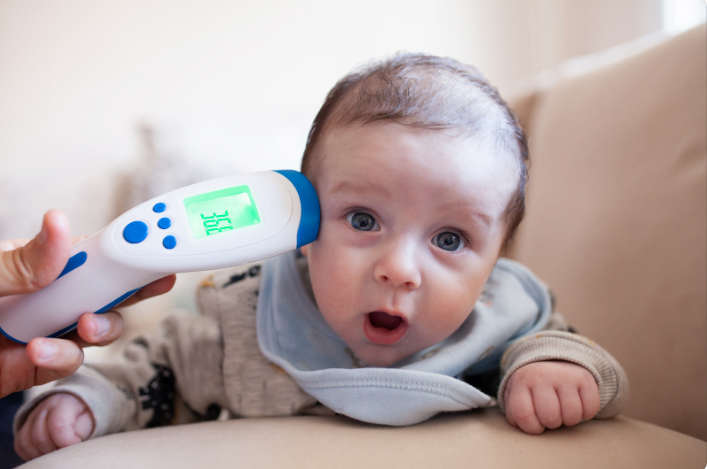Understanding and managing a baby’s first fever can be a daunting task for any parent. It’s crucial to know how to recognize, treat, and prevent fevers to ensure the well-being of your child. This comprehensive guide aims to provide you with all the necessary information to handle your baby’s first fever with confidence.
2. What is a Fever?
A fever is defined as a temporary increase in body temperature, often due to an illness. For babies, a normal body temperature ranges between 97°F (36.1°C) and 100.4°F (38°C). When a baby’s temperature exceeds this range, it is considered a fever, typically a sign that the body is fighting off an infection.
3. Signs and Symptoms of Fever in Babies
Recognizing a fever in your baby is the first step in managing it. Common symptoms include:
- Warm forehead
- Sweating
- Shivering
- Dehydration
- Reduced appetite
- Irritability
If your baby is under three months old and has a fever over 100.4°F (38°C), seek medical attention immediately.
4. Common Causes of Fever in Babies
Fever in babies can be caused by various factors, including:
- Viral infections: Such as colds or flu.
- Bacterial infections: Like ear infections or urinary tract infections.
- Teething: Although controversial, some believe teething can cause a mild fever.
- Immunizations: Vaccinations can sometimes trigger a low-grade fever.
- Other causes: Overheating or wearing too many clothes.
5. Measuring Your Baby’s Temperature
There are several methods to measure your baby’s temperature:
- Rectal: Most accurate for infants.
- Oral: Suitable for older babies.
- Axillary (underarm): Less accurate but easier.
- Temporal artery (forehead): Convenient and fairly accurate.
To use a digital thermometer rectally:
- Clean the thermometer with rubbing alcohol.
- Lubricate the tip with a water-based lubricant.
- Place your baby on their back, lift their legs, and gently insert the thermometer about half an inch to an inch into the rectum.
- Hold the thermometer in place until it beeps.

6. Understanding Fever Readings
Fever readings can indicate different levels of concern:
- Low-grade fever: 100.4°F to 102°F (38°C to 38.9°C)
- Moderate fever: 102°F to 104°F (38.9°C to 40°C)
- High-grade fever: Above 104°F (40°C)
Normal body temperature can vary throughout the day, so consider other symptoms and overall behavior when assessing your baby’s health.
7. Home Remedies for Managing Fever
You can manage your baby’s fever at home with simple remedies:
- Hydration: Ensure your baby drinks plenty of fluids to prevent dehydration.
- Rest: Allow your baby to rest and sleep as much as needed.
- Appropriate clothing: Dress your baby in light clothing and use a light blanket if necessary.
- Lukewarm baths: A lukewarm bath can help lower body temperature.
- Using a fan or cool compress: Apply a cool, damp cloth to the forehead.

8. Over-the-Counter Medications
For babies over three months old, certain medications can help reduce fever:
- Acetaminophen: Suitable for babies over three months. Follow dosage guidelines based on your baby’s weight.
- Ibuprofen: For babies over six months. Again, follow the recommended dosage.
Always consult your pediatrician before giving any medication to your baby, especially if they are under three months old.
9. When to Contact a Pediatrician
It’s crucial to know when to seek medical advice:
- Newborns (under three months): Any fever over 100.4°F (38°C).
- Persistent fever: Lasting more than three days.
- High fever: Over 104°F (40°C).
- Additional symptoms: Such as a rash, difficulty breathing, persistent crying, or seizures.
10. Preventing Fever in Babies
Preventative measures can reduce the risk of fever:
- General hygiene practices: Regular handwashing and avoiding close contact with sick individuals.
- Immunizations: Keeping up-to-date with vaccinations.
- Nutrition and health: A balanced diet to strengthen the immune system.
- Avoiding exposure to sick individuals: Minimizing contact with those who are ill.
11. Understanding the Role of the Immune System
A fever is often a sign that the body is fighting an infection. The immune system in babies is still developing, and a fever can be a natural response to help eliminate pathogens. Supporting your baby’s immune system through proper nutrition, adequate sleep, and regular vaccinations can help reduce the frequency and severity of fevers.
12. Teething and Fever: Is There a Connection?
There’s a common belief that teething causes fever, but research suggests otherwise. Teething might cause a slight increase in temperature but not a significant fever. Managing teething discomfort can involve using teething rings, gentle gum massages, and maintaining good oral hygiene.
13. Post-Immunization Fever
Fever after immunizations is a normal response as the body builds immunity. This type of fever is typically mild and short-lived. Manage it with the same home remedies and medications mentioned earlier. Monitor your baby closely and consult your pediatrician if the fever persists or if you notice any concerning symptoms.
14. Complications of Untreated Fever
Untreated fever can lead to complications such as:
- Febrile seizures: Seizures triggered by fever, common in young children.
- Dehydration: Due to increased fluid loss.
- Serious infections: If the underlying cause is not addressed.
15. Special Considerations for Newborns
Newborns are particularly vulnerable to fevers and infections. For babies under three months, even a slight fever warrants immediate medical attention. Maintain regular check-ups and monitor your newborn closely for any signs of illness.
16. Dealing with Recurrent Fevers
If your baby experiences recurrent fevers, it could indicate an underlying issue such as an autoimmune disorder or chronic infection. Consult your pediatrician for a thorough evaluation and appropriate management plan.









